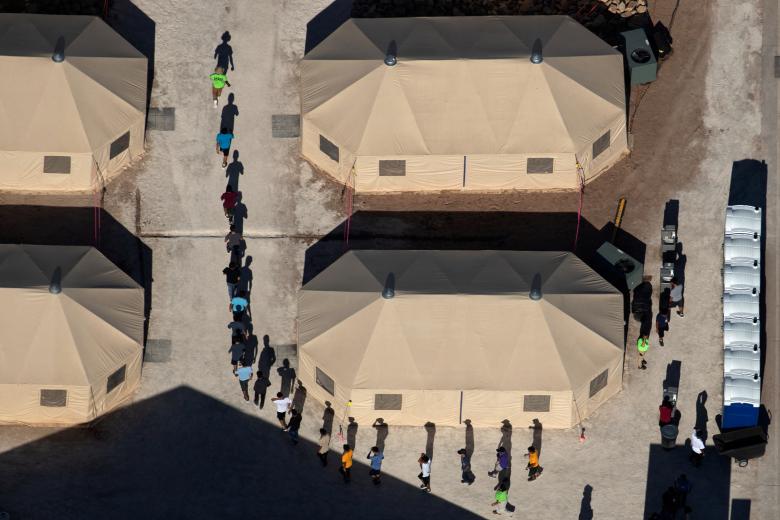
Immigrant children, suspected of illegal border crossings, are led by staff in single file between tents at a detention facility next to the Mexican border in Tornillo, Texas, June 18, 2018. It was not immediately clear whether these “unaccompanied minors” were apprehended without adults or separated from parents under a “zero tolerance” policy by the Trump administration. (REUTERS/Mike Blake)
Lindsay Charlton
U.S. District Court Judge Dana Sabraw ordered Washington to reunite separated migrant families within 30 days, but the decision raised many questions.
Attorney General Jeff Sessions’ “Zero-Tolerance Policy” on immigration that divided families seeking asylum created a nationwide uproar when it was adopted in May.
Shock turned to horror when an audio clip and photos on the internet of screaming and crying children being ripped away from their parents were released. Advocacy groups, policy makers and the general public demanded a policy reform and reunite roughly 2,300 children with their families.
Sabraw stepped in June 26 with an order to bring these families back together. Children under five are to be reunited with their parents within 14 days, and older children within 30. This order however, may not be so simple to execute, says a legal expert.
“I think it’s great that we have this order but it’s absolutely unrealistic given the fact that we don’t know what will happen even if these families get reunited,” said Veronica Thronson, Director of the Immigration Law Clinic at the Michigan State University College of Law.
There are many pieces to the puzzle in getting the families together but the writ isn’t clear on how to fulfill it, creating more questions than answers, she said.
“Does that mean they are going to be reunited in the detention facilities? We really don’t have the capacity. Or does it mean that the order would allow for the government to have alternatives to detention? So that’s an issue that we don’t know and many parents have no idea where their children are being held and so it’s going to be pretty confusing,” Thronson said.
The kids are sent to facilities in different states across the country, which adds to the difficulty of finding their parents, she said.
“Michigan has two facilities. So some of the kids are being held here. The problem is for those kids that are brought here under short term, they are not brought within jurisdiction of the family courts as opposed to when the kids are in long term,” Thronson said.
“So that’s an issue too because the courts really don’t know that there are kids here,” she said.
“So it’s going to be a mess,” Thronson said. “It’s going to be a mess especially with kids who are little who are not able to tell you who their parent is. So how are you going to be able to figure that out?”
The Vera Institute of Justice, a non-profit policy organization, is trying to do that, seeking information like the child’s name, gender, language and other personal details to find a parental match. It is working with theOffice of Refugee Resettlement, which is in charge of the custody and care of the children.
Although Sabraw ordered from his San Diego bench the halt of separating families even for those entering illegally unless the parent is deemed unfit, it doesn’t mention the parents who have already been criminally charged under the Zero-Tolerance Policy and are going through the criminal court system.
“Let’s say a mom is facing criminal charges, while that mom is waiting for her hearing she can actually try to locate her child and check on the status of her child,” Thronson explained. “After they serve their sentence then they are transferred to the ICE (Immigration and Customs Enforcement) detention centre, and once they are in the ICE centre they are put in contact with their children and hopefully someone is trying to figure out that this mom matches this child, you’re hoping that this is happening.”
Once families are reunited they are not necessarily freed. Since the U.S. has the right to detain asylum seekers as well as those charged, facilities may fill up quickly and many do not have the resources to care for small children.
“We don’t know how this is going to happen because if you are claiming asylum, the government has the right to hold you in detention and so if they hold you and they bring your kid to you, then the court has to say ‘okay it’s fine to keep the family together but still detained,” she said.
It’s unclear how the capacity and facility issues will be handled as many of the detention facilities holding parents do not have resources for children, Thronson said.
“I think [the order] is great and it’s definitely the right way to try to reunite people except that if we are going to continue to detain them, then the problem is going to be that we are going to have really tight facilities that are not set to hold children,” she said.
The Flores Agreement, based on a 1990s court case, states children cannot be detained for more than 20 days, bringing another caveat into finding out where these families are going to go once reunited.
Thronson brought up that there used to be bracelets that parents could wear so they could be free and living in the community with their families but would be require to present themselves for various ICE check-ins.
“If they went back to those alternatives to detention that would actually work for some families,” she said.

